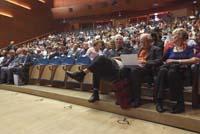Atom by Atom, research for all audiences

From virus packaging capability to breakthroughs of spintronics that has made it possible to miniaturize the hard drives of electronic devices. These include the possibilities offered by the molecules that form fat and the contribution of nanotechnology to the energy challenge. All of them, and more, were treated at the Kursaal during the Atom by Atom congress.
At conferences, experts from a specific research area usually meet to inform their team about the research and results obtained. Atom by Atome also had room for this, but it also had another objective: to bring experts closer to the street public to publicize their research and, fundamentally, to show what nanoscience and nanotechnology are.
San Sebastián dedicated three days to nanoscience and nanotechnology, in which eight renowned experts participated: Sir Harold Kroto, winner of the 1996 Nobel Prize in Chemistry, Felix Goñi, expert in biochemistry and molecular biology, the prestigious physicist Emilio Méndez, biophysicist Carlos Bustamante, Juan Colmenero of the Materials Physics Center, physicist Nobel José Fertmaiz, Sir Pendraly Prize 2007.
Guest star, Sir Harold Kroto
Kroto offered the welcome conference to the congress. The theme was science, society and sustainability, that is, the importance of science and science in society. Therefore, nanoscience and nanotechnology were few in Kroto's words.

Yes, it showed an enormous ability to communicate. In a very entertaining and sometimes humorous way, he said what had to be told. But they were not nonsense. He noted, for example, that funding to conduct research requires ensuring fruitful results. In science, however, "it cannot be predicted, that is so. It's not my fault," he said.
At another point in his speech he commented on the contribution of science to society to solve the problems it has had at certain times. For example anaesthesia and penicillin. Now the problems have changed and researchers are needed to solve them: "When you are a scientist you realize that the future depends on no one," he said.
Two days of nanoscience and nanotechnology
Over the next two days, experts focused on nanoscience and nanotechnology. In a thousand and one ways the size of the nanoscale was explained, the possibility of working the matter atom to atom, both in physics, chemistry and biology, etc.
Undoubtedly, the person most cited by the speakers was Richard Feynman. He was the first to dictate the basic principles of nanoscience and is well known the speech he delivered in 1959, called There's Plenty of Room at the Bottom. Many remembered what was said at that conference, for example, that at that time we were too big to work one by one with atoms, that is, atom by atom.

In this sense, someone commented when we became small enough to work on this scale, and they named physicist Heinrich Rohrer who was in the same congress. In fact, it was he who, along with Gerd Binning, invented tunnel-effect microscopy – hence the Nobel Prize in Physics in 1986. This has allowed him to enjoy the boom of nanotechnology.
Rohrer was there, but he gave no lecture. In fact, it came for the meeting that took place in the Kutxaespacio de la Ciencia with students from 4th of ESO and 1st and 2nd of Baccalaureate. However, in the talks it was noticed that he was there, as he participated in the interrogation after all the talks, if not to ask any questions, to make some suggestion.
Apart from those who spoke generally about nanoscience and nanotechnology, among those who spoke about their area of research it was seen that not everyone had the same ability to divulge. As pointed out by Unai Ugalde, one of the organizers of the congress, Bustamante offered a first class conference, "perhaps the best conference of the congress." He explained the studies being carried out to better understand how viruses do to introduce all the DNA that needs to be introduced into protein capsules. This process was exposed in several videos directly and the explanations were clear and clear.
At the other extreme, there were also difficulties in simplifying the investigations carried out in their field and making them accessible to all. Fud's lecture, for example, was very intense and profound. Ugalde has pointed out that it was very difficult to understand what he said. However, "what made clear the inventor of spintronics is that it has opened a new world."





